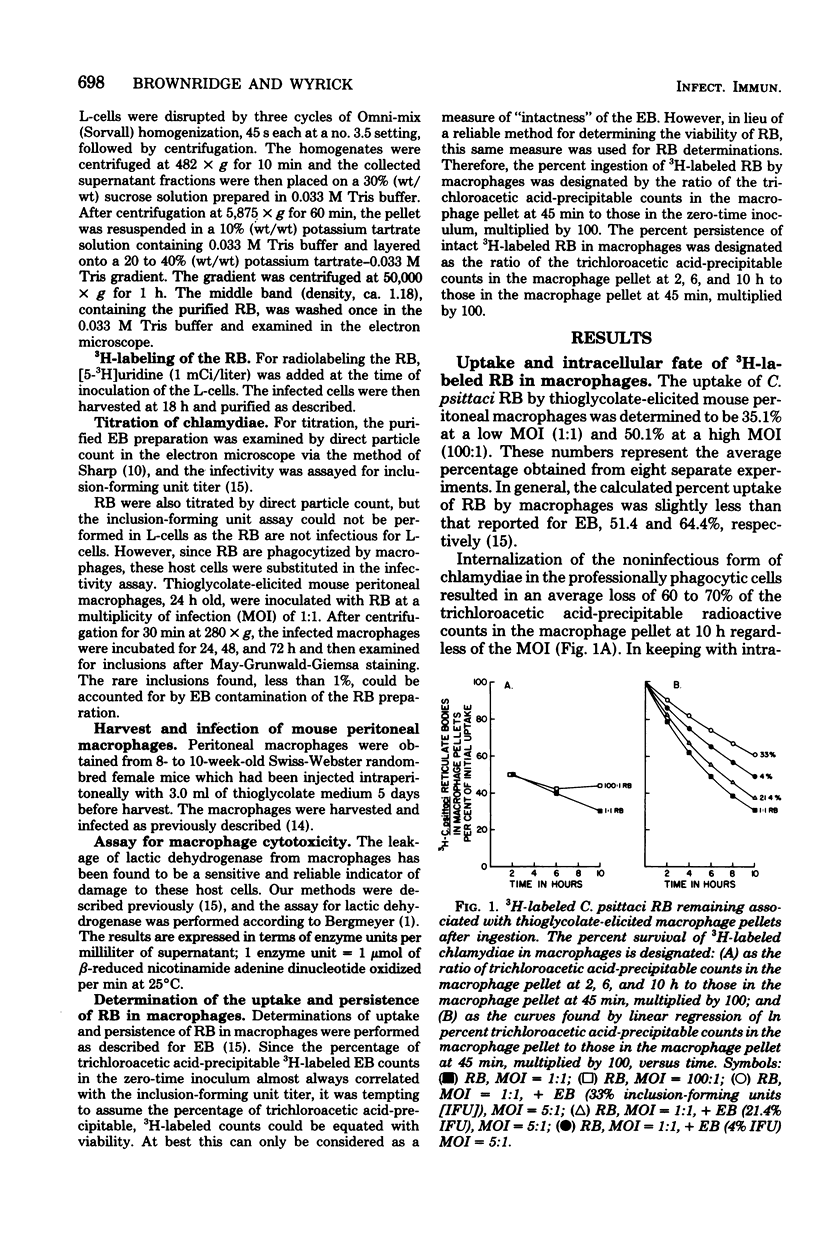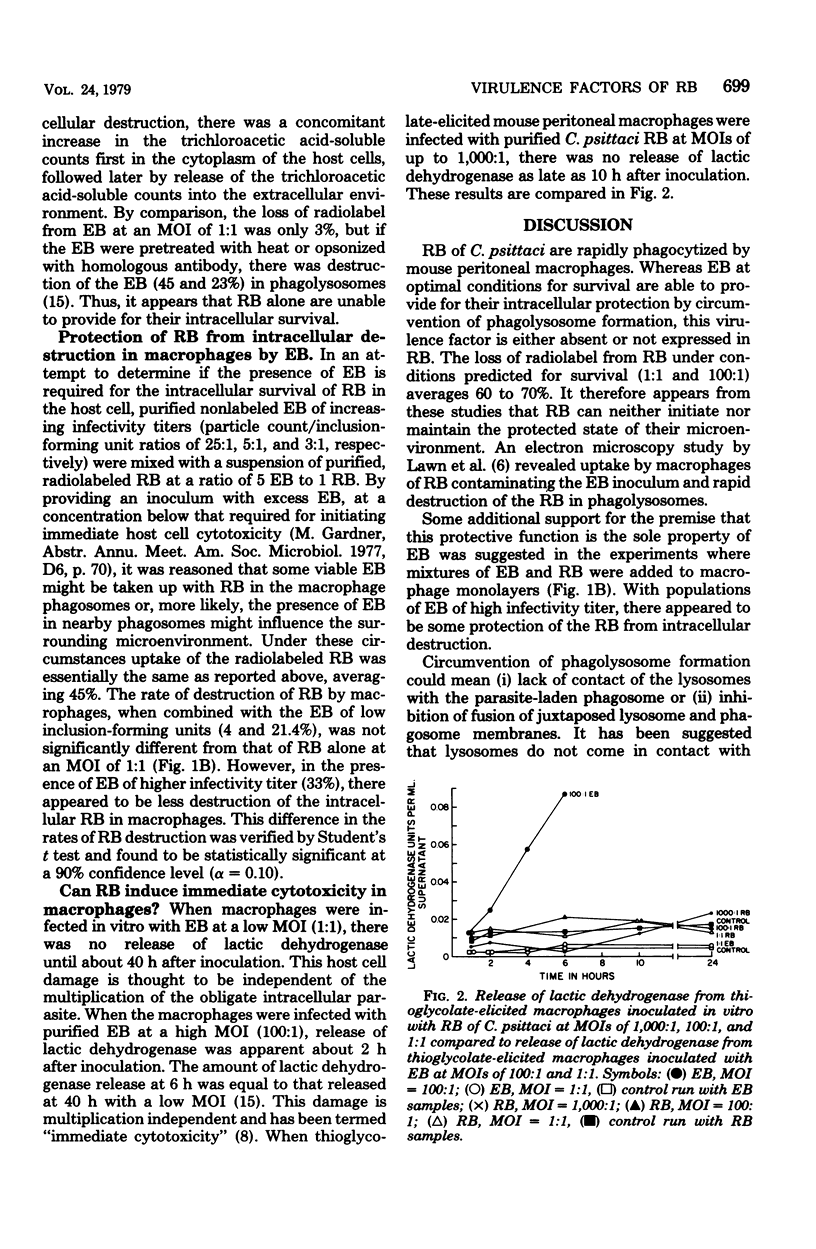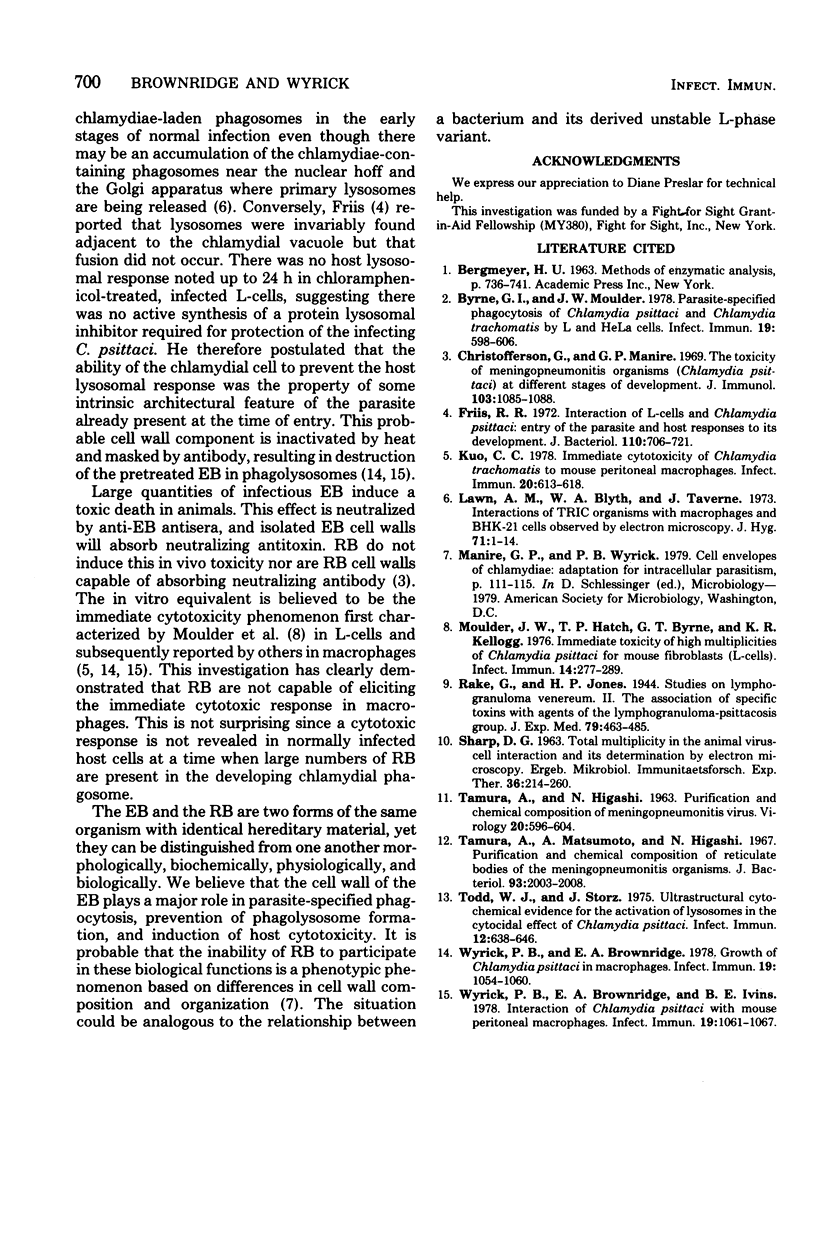Abstract
Noninfectious reticulate bodies of Chlamydia psittaci are readily phagocytized by thioglycolate-elicited mouse peritoneal macrophages in monolayer culture. The internalized reticulate bodies are rapidly destroyed as indicated by a 60 to 70% decrease in trichloroacetic acid-precipitable radioisotopic counts in the macrophage pellet by 10 h and a concomitant increase of the trichloroacetic acid-soluble radiolabeled chlamydial nucleic acid in the cytoplasm. This intracellular destruction of reticulate bodies in macrophages is independent of the multiplicity of infection. Reticulate bodies at a high multiplicity of infection, up to 1,000:1, are also incapable of inducing immediate cytotoxicity in macrophages as evidenced by the lack of early release of the host cell-soluble cytoplasmic enzyme lactic dehydrogenase. Thus, it appears that the virulence factors for (i) initiation or maintenance of intracellular survival via circumvention of phagolysosome formation and (ii) host cell damage are either missing or not expressed by the RB form of this bacterium.
Full text
PDF



Selected References
These references are in PubMed. This may not be the complete list of references from this article.
- Burgess N. R., McDermott S. N., Whiting J. Aerobic bacteria occurring in the hind-gut of the cockroach, Blatta orientalis. J Hyg (Lond) 1973 Mar;71(1):1–7. doi: 10.1017/s0022172400046155. [DOI] [PMC free article] [PubMed] [Google Scholar]
- Byrne G. I., Moulder J. W. Parasite-specified phagocytosis of Chlamydia psittaci and Chlamydia trachomatis by L and HeLa cells. Infect Immun. 1978 Feb;19(2):598–606. doi: 10.1128/iai.19.2.598-606.1978. [DOI] [PMC free article] [PubMed] [Google Scholar]
- Christoffersen G., Manire G. P. The toxicity of meningopneumonitis organisms (Chlamydia psittaci) at different stages of development. J Immunol. 1969 Nov;103(5):1085–1088. [PubMed] [Google Scholar]
- Friis R. R. Interaction of L cells and Chlamydia psittaci: entry of the parasite and host responses to its development. J Bacteriol. 1972 May;110(2):706–721. doi: 10.1128/jb.110.2.706-721.1972. [DOI] [PMC free article] [PubMed] [Google Scholar]
- Kuo C. C. Immediate cytotoxicity of Chlamydia trachomatis for mouse peritoneal macrophages. Infect Immun. 1978 Jun;20(3):613–618. doi: 10.1128/iai.20.3.613-618.1978. [DOI] [PMC free article] [PubMed] [Google Scholar]
- Moulder J. W., Hatch T. P., Byrne G. I., Kellogg K. R. Immediate toxicity of high multiplicities of Chlamydia psittaci for mouse fibroblasts (L cells). Infect Immun. 1976 Jul;14(1):277–289. doi: 10.1128/iai.14.1.277-289.1976. [DOI] [PMC free article] [PubMed] [Google Scholar]
- TAMURA A., HIGASHI N. PURIFICATION AND CHEMICAL COMPOSITION OF MENINGOPNEUMONITIS VIRUS. Virology. 1963 Aug;20:596–604. doi: 10.1016/0042-6822(63)90284-8. [DOI] [PubMed] [Google Scholar]
- Tamura A., Matsumoto A., Higashi N. Purification and chemical composition of reticulate bodies of the meningopneumonitis organisms. J Bacteriol. 1967 Jun;93(6):2003–2008. doi: 10.1128/jb.93.6.2003-2008.1967. [DOI] [PMC free article] [PubMed] [Google Scholar]
- Todd W. J., Storz J. Ultrastructural cytochemical evidence for the activation of lysosomes in the cytocidal effect of Chlamydia psittaci. Infect Immun. 1975 Sep;12(3):638–646. doi: 10.1128/iai.12.3.638-646.1975. [DOI] [PMC free article] [PubMed] [Google Scholar]
- Wyrick P. B., Brownridge E. A. Growth of Chlamydia psittaci in macrophages. Infect Immun. 1978 Mar;19(3):1054–1060. doi: 10.1128/iai.19.3.1054-1060.1978. [DOI] [PMC free article] [PubMed] [Google Scholar]
- Wyrick P. B., Brownridge E. A., Ivins B. E. Interaction of Chlamydia psittaci with mouse peritoneal macrophages. Infect Immun. 1978 Mar;19(3):1061–1067. doi: 10.1128/iai.19.3.1061-1067.1978. [DOI] [PMC free article] [PubMed] [Google Scholar]


